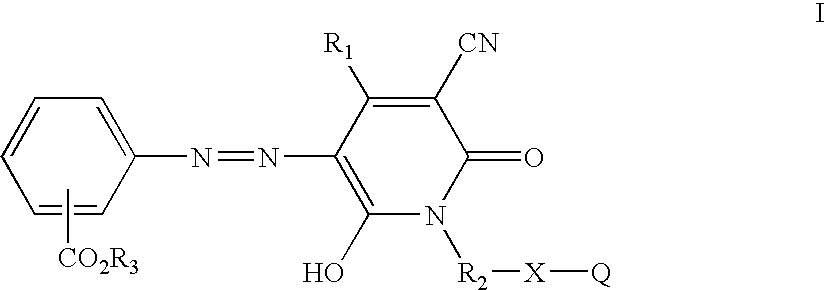Azo compounds and coating compositions containing the azo compounds
- Summary
- Abstract
- Description
- Claims
- Application Information
AI Technical Summary
Benefits of technology
Problems solved by technology
Method used
Image
Examples
example 1
[0031] Methyl cyanoacetate (198 g, 2.0 moles) was stirred and heated to about 100° C. and 2-aminoethanol (122 g, 2.0 moles) was added dropwise over 2.0 hours at about 95-105° C. while methanol was collected in a Dean-Stark trap. The reaction mixture was heated to about 150° C. and held at that temperature until methanol distillation stopped. The reaction mixture was allowed to cool to room temperature. Ethyl acetoacetate (260 g, 2.0 moles) was added and the reaction mixture was heated to reflux. A solution of potassium hydroxide (125 g) dissolved in methanol (300 mL) was added dropwise and refluxing was continued for about 7.0 hours. After 2-3 hours of heating, a rather thick slurry of the potassium salt of the pyridone product resulted. The reaction mixture was allowed to cool and the white solid was collected by filtration, washed with a small amount of cold methanol and dried in air to give 314 g of product. The potassium salt was dissolved in water (500 mL) and stirred while bei...
example 2
[0034] Nitrosylsulfuric acid (40%, 6.4 g, approximately 0.02 mole) was added to a 100 mL round bottomed flask equipped with a magnetic stir bar and ice water bath. To the stirred solution was added 1:5 acid (20 mL) was added in small portions such that the temperature did not exceed 25° C. The reaction solution was further cooled and isobutyl anthranilate (3.86 g, 0.02 mole) was added at about 0-5° C. with stirring and cooling, followed by an additional quantity (20 mL) of 1:5 acid. The diazotization reaction solution was stirred at 0-5° C. for about 2 hours then added dropwise at less than about 5° C. to a solution of 3-cyano-6-hydroxy-1-(2′-hydroxyethyl)-4-methyl-2-pyridone potassium salt (4.64 g, 0.02 mole), dissolved into an ice water mixture (100 mL). The coupling mixture was allowed to sit in the ice water bath with occasional stirring about 45 minutes and diluted with water (100 mL). The yellow, intermediate azo compound was collected by vacuum filtration, washed hot water an...
example 3
[0036] Nitrosylsulfuric acid (40%, 6.4 g, approximately 0.02 mole) was added to a 100 mL round bottomed flask equipped with a magnetic stir bar and ice water bath. To the stirred solution was added 1:5 acid (20 mL) in small portions such that the temperature did not exceed 25° C. The reaction solution was further cooled and 2-ethylhexyl anthranilate (5.08 g, 0.02 mole) was added at about 0-5° C. with stirring and cooling, followed by an additional quantity (20 mL) of 1:5 acid. The diazotization reaction solution was stirred at 0-5° C. for about 2 hours, then added dropwise at less than about 5° C. to a solution of 3-cyano-6-hydroxy-1-(2′-hydroxyethyl)-4-methyl-2-pyridone potassium salt (4.64 g, 0.02 mole) dissolved in an ice water mixture (100 mL). The coupling mixture was allowed to sit in the ice water bath with occasional stirring about 45 minutes and diluted with water (100 mL). The yellow intermediate azo product was collected by vacuum filtration, washed hot water and air drie...
PUM
| Property | Measurement | Unit |
|---|---|---|
| Percent by mass | aaaaa | aaaaa |
| Percent by mass | aaaaa | aaaaa |
| Weight | aaaaa | aaaaa |
Abstract
Description
Claims
Application Information
 Login to View More
Login to View More - R&D
- Intellectual Property
- Life Sciences
- Materials
- Tech Scout
- Unparalleled Data Quality
- Higher Quality Content
- 60% Fewer Hallucinations
Browse by: Latest US Patents, China's latest patents, Technical Efficacy Thesaurus, Application Domain, Technology Topic, Popular Technical Reports.
© 2025 PatSnap. All rights reserved.Legal|Privacy policy|Modern Slavery Act Transparency Statement|Sitemap|About US| Contact US: help@patsnap.com



